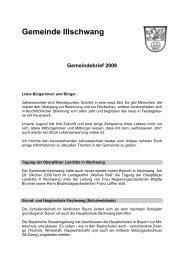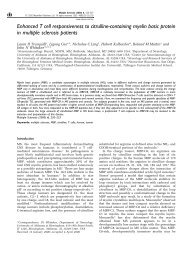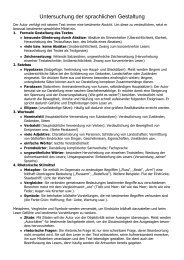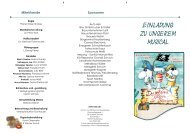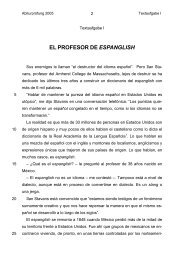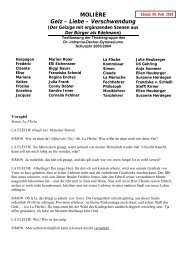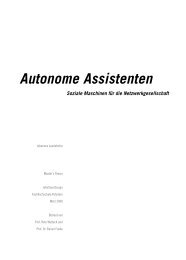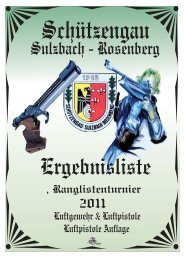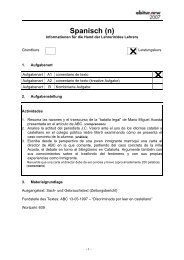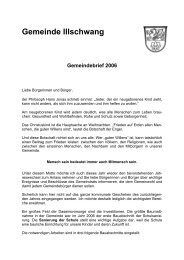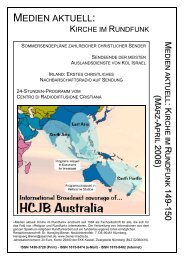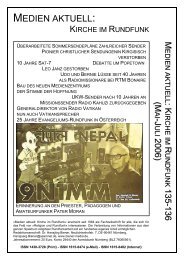Pathfinder Chronicles - Gazetteer - Asamnet
Pathfinder Chronicles - Gazetteer - Asamnet
Pathfinder Chronicles - Gazetteer - Asamnet
Create successful ePaper yourself
Turn your PDF publications into a flip-book with our unique Google optimized e-Paper software.
<strong>Pathfinder</strong> <strong>Chronicles</strong><br />
16<br />
goal, be it knowledge, power, or fame, is never far from<br />
a wizard’s thoughts.<br />
Appearance: Many wizards are so driven by their<br />
goals that personal appearance is of little concern. After<br />
all, when plumbing the depths of the universe, what difference<br />
does the cleanliness of your robe make? Others<br />
care deeply about their raiment, preferring to dress in<br />
a manner befitting their power and prestige, wearing<br />
colorful robes decked with gems, precious metals, and<br />
magical trinkets.<br />
Nations: Wizards are a varied lot and can be found<br />
in nearly any community. There are great wizard<br />
colleges in Absalom, Cheliax, Geb, Kyonin, Nex, Nidal,<br />
Rahadoum, and Varisia, all of which focus on their own<br />
individual philosophies.<br />
Class Abilities: Wizards who train at the Arcanamirum,<br />
a famous college of the magical arts located in Absalom,<br />
spend much of their time studying the practical<br />
applications of their spells, often in the school’s dueling<br />
fields. As such, some of them have learned the arcane<br />
duelist special ability, which replaces the Scribe Scroll<br />
feat gained at 1st level.<br />
Arcane Duelist (Su): Wizards with this ability are specially<br />
trained to push their spells when needed to gain the upper<br />
hand. When pushing a spell, the wizard can choose<br />
one of the three following effects: increase a spell’s DC by<br />
+1, add +2 to the level check to ove come spell resistance,<br />
or add a +2 morale bonus on attack rolls made with the<br />
spell. A wizard can use this ability a number of times per<br />
day equal to his Intelligence bonus. Using this ability is a<br />
swift action.<br />
lanGuaGes<br />
Hundreds of languages and dialects are spoken in the Inner<br />
Sea region. The following list presents a broad overview of<br />
some of the most prominent human languages.<br />
Azlanti: The living language of Old Azlant died with<br />
the destruction of its home continent eons ago. Survivors<br />
f leeing the devastation of their homeland mixed with local<br />
populations in Avistan and elsewhere, and the human<br />
cultures that f lowered during the Age of Destiny often<br />
rightfully claim lineage dating back to the earliest known<br />
advanced human society on the planet. Thus, Azlanti<br />
words and grammatical structure serve as the foundation<br />
of Taldane, the most commonly spoken language in the<br />
region. Certain Azlanti words survive to the present day, but<br />
it generally takes a scholar or the employment of magic to<br />
decipher the time-faded glyphs of secluded (or submerged)<br />
ancient ruins on what remains of the devastated, largely<br />
sunken continent of Azlant. Only the mysterious sea elves<br />
of the Mordant Spire speak the language f luently, barking<br />
aristocratic orders to explorers they discover investigating<br />
the Azlanti ruins they claim as their own.<br />
Common (Taldane): Taldane is the ancient tongue of<br />
the kingdom of Taldor, whose borders have encompassed<br />
much of Avistan in the five millennia since its founding<br />
on the eastern shores of the Inner Sea. Because the<br />
language’s inf luence expands as far north as Varisia and<br />
even into Garund in the south, Taldane is sometimes<br />
called Common or the Common Tongue. When Cheliax<br />
split from Taldor, the language remained the official<br />
tongue of the new empire, whose residents often call it<br />
Chelaxian. No matter what it is called, however, Taldane<br />
is the language most likely to be understood throughout<br />
the Inner Sea region. Taldane’s root language is Azlanti,<br />
but certain Kelish, Skald, and even Hallit terms and<br />
concepts have worked their way into common usage in the<br />
thousands of years since the language first took form.<br />
Hallit: The harsh Kellid tongue of Hallit is considered<br />
by most cultured folk a crude language of illiterate<br />
barbarians. Modulations of tone and volume play a much<br />
stronger role in its construction than in other languages,<br />
often resulting in speech that sounds like a heated<br />
argument. The tongue has no formal written form (as<br />
most of its speakers do not read or write). Frontier scholars<br />
of the River Kingdoms have, throughout the centuries,<br />
pieced together several competing systems of phonetic<br />
transcriptions that often do more to confuse the issue<br />
than to help it. Because many menials in Absalom and the<br />
borders of the old Chelish empire speak Hallit, the tongue<br />
is often used by servants wishing to speak freely under the<br />
noses of their unwitting masters.<br />
Kelish: The domain of the Padishah Emperor of Kelesh,<br />
greatest of the Diamond Sultanates, sprawls across much<br />
of central Casmaron. From the shining sands of Qadira<br />
on the Inner Sea to the edge of distant Vudra, the Kelish<br />
tongue—throaty, phlegmatic, passionate—holds sway.<br />
Its f lorid script recalls banners in f light, twisting and<br />
turning on the desert winds.<br />
Osiriani: The national language of Ancient Osirion is<br />
the oldest known living human language spoken in the<br />
Inner Sea region (save perhaps Vudrani, if that culture’s<br />
improbable mythology is to be believed). The language<br />
contains predominantly short-syllable words combined<br />
in bewilderingly complex patterns and arcane hierarchies<br />
of syntax. Its written form is hieroglyphic in nature and<br />
highly symbolic.<br />
Polyglot: The countless tongues of Garund’s Mwangi<br />
tribesfolk share enough remnants of a mysterious root<br />
language that members of different tribes from vastly<br />
divergent regions of the Expanse can generally understand<br />
one another even though they appear to be speaking<br />
completely different languages. No written form of modern<br />
Polyglot exists, but ruined cities and vast monuments half-



